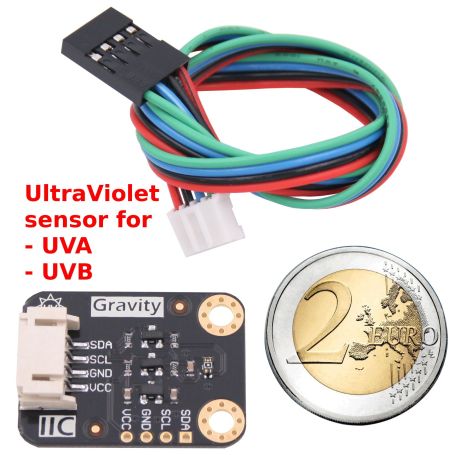Gravity : VEML6075 UV sensor, I2C
Ultraviolet Sensor, Gravity Interface
- VEML6075 sensor
- UVA (350 à 375nm)
- UVB (315 à 340nm)
- UV-I (UltraViolet Index) in visible light
- 3.3 to 5V
- I2C interface
Payments are secured by LyraCollect, a French payment collection company.
It is possible to delivered to your home, to a pick-up point or picked up by appointment at MCHobby
We prepare, pack and ship your orders with great respect and care.
Measure UVA and UVB with the VEML6075 sensor
This sensor is not like its competitor. Based on the the Vishay VEML6075 sensor chip, it have 2 measurement channels for UVA & UVB with 16-bit resolution.
This sensor converts the Sun UV light intensity to digital data read over the I2C bus and offers an accurate measure of internal signal strength.
The VEML6075 UV sensor provides reliable UV radiation measurement under long time solar UV exposure. The reliability is possible thanks to the excellent temperature compensation capability of the sensor (-40°C to +85°C). VEML6075 is a low power consumption sensor with a minimum power as low as 800nA in shut-down mode.
As it operates in a voltage ranges from 3.3V to 5V, it can be used with Arduino, Raspberry-Pi, Pyboard, PYBStick to create portable electronic product, wearable device, weather station, flame detecting, etc.
DFRobot offers Arduino a Python library while MC Hobby offers the MicroPython driver for this sensor.
Thanks to the gravity connector (PH2.0-4P) and its I2C wiring gravity cable (4wires), this sensor is quite easy to plug onto the Gravity/Boson EcoSystem or onto the breadboard (thank to the awesome 2.54mm female connector on the cable).
This sensor is designed to work with the sun light!
As stated in the application notes:
MECHANICAL CONSIDERATIONS AND WINDOW CALCULATIONS FOR THE VEML6075:
As already mentioned, this UVA / UVB sensor will need a well-selected cover that is not only completely transmissive to visible light (400 nm to 700 nm), but also to UVA and UVB wavelengths (280 nm to 400 nm) and up to near infrared wavelengths from 700 nm to 1000 nm.
Si ce sensor must receive lights from UV wavelength to IR wavelength (including visible light and and the infrared over the visible light!)
Various type of UV light
The ultraviolet section of the electromagnetic spectrum extends from 400 nm to 100 nm, just below the X-ray section of the spectrum. The Ultraviolet range is divided in 3 sub-ranges:
- UVA from 400 nm to 315 nm: also called "black lights" used to creates ” that are used for eerie lighting effects. The UVA is not absorbed by the ozone layer.
- UVB from 315 nm to 280 nm: The lights used in tanning booths. Most of the UVB is absorbed by the ozone layer, so it reduce the UVB energy even if some UVB gets through.
- UVC from 280 nm to 100 nm: This UV light range have a high energy. It is close from X-Ray range and is difficult to measure with typical UV sensor. This UV range is used for sterilization process because it can kills bacteria with its high energy.
The UVC are completely absorbed by the ozone layer and upper atmosphere.
The UV-C measurement is discussed in this MCHobby Forum thread.
Tutorial
- VEML6075 sensor with MicroPython (MCHobby, GitHub)
- Ultraviolet UV VEML6075 sensor (DFRobot, Wiki, English)
- Manufacturer product sheet (DFRobot, English)
Access to the manual and schematics - Vishay VEML6075 Application notes (pdf, English)







